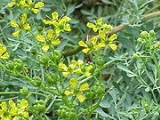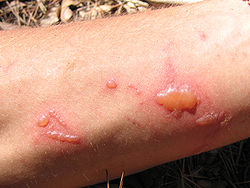
Common Rue
Encyclopedia
The Common Rue also known as Herb-of-Grace, is a species of rue
grown as a herb
. It is native to the Balkan Peninsula, southeastern Europe
. It is sometimes grown as an ornamental plant
in garden
s, especially because of its bluish leaves, and also sometimes for its tolerance of hot and dry soil
conditions. It also is cultivated
as both a medicinal herb, as a condiment, and to a lesser extent as an insect repellent.
The caterpillars of Papilio machaon butterfly species feed on Rue, among other kinds of plants.
and the gynecologist Soranus as a potent abortifacient
(inducing abortion). Rue contains pilocarpine
which is used in horses to induce abortion.
It is also used in Brazil as the key ingredient in homemade herbal cough syrup, when mashed with caramelized sugar and honey.
Exposure to Common Rue, or herbal preparations derived from it, can cause severe phytophotodermatitis
which results in burn-like blisters on the skin.

, both as a low hedge and so the leaves can be used in nosegay
s.
Most cats dislike the smell of it and therefore it can be used as a deterrent to them (see also Plectranthus caninus
).
Rue
Rue is a genus of strongly scented evergreen subshrubs 20–60 cm tall, in the family Rutaceae, native to the Mediterranean region, Macaronesia and southwest Asia. There are perhaps 8 to 40 species in the genus...
grown as a herb
Herb
Except in botanical usage, an herb is "any plant with leaves, seeds, or flowers used for flavoring, food, medicine, or perfume" or "a part of such a plant as used in cooking"...
. It is native to the Balkan Peninsula, southeastern Europe
Europe
Europe is, by convention, one of the world's seven continents. Comprising the westernmost peninsula of Eurasia, Europe is generally 'divided' from Asia to its east by the watershed divides of the Ural and Caucasus Mountains, the Ural River, the Caspian and Black Seas, and the waterways connecting...
. It is sometimes grown as an ornamental plant
Ornamental plant
Ornamental plants are plants that are grown for decorative purposes in gardens and landscape design projects, as house plants, for cut flowers and specimen display...
in garden
Garden
A garden is a planned space, usually outdoors, set aside for the display, cultivation, and enjoyment of plants and other forms of nature. The garden can incorporate both natural and man-made materials. The most common form today is known as a residential garden, but the term garden has...
s, especially because of its bluish leaves, and also sometimes for its tolerance of hot and dry soil
Soil
Soil is a natural body consisting of layers of mineral constituents of variable thicknesses, which differ from the parent materials in their morphological, physical, chemical, and mineralogical characteristics...
conditions. It also is cultivated
Horticulture
Horticulture is the industry and science of plant cultivation including the process of preparing soil for the planting of seeds, tubers, or cuttings. Horticulturists work and conduct research in the disciplines of plant propagation and cultivation, crop production, plant breeding and genetic...
as both a medicinal herb, as a condiment, and to a lesser extent as an insect repellent.
The caterpillars of Papilio machaon butterfly species feed on Rue, among other kinds of plants.
Traditional use
Common Rue is said to promote the onset of menstruation and of uteral contractions; for this reason the refined oil of rue was cited by the Roman historian Pliny the ElderPliny the Elder
Gaius Plinius Secundus , better known as Pliny the Elder, was a Roman author, naturalist, and natural philosopher, as well as naval and army commander of the early Roman Empire, and personal friend of the emperor Vespasian...
and the gynecologist Soranus as a potent abortifacient
Abortifacient
An abortifacient is a substance that induces abortion. Abortifacients for animals that have mated undesirably are known as mismating shots....
(inducing abortion). Rue contains pilocarpine
Pilocarpine
Pilocarpine is a parasympathomimetic alkaloid obtained from the leaves of tropical American shrubs from the genus Pilocarpus. It is a non-selective muscarinic receptor agonist in the parasympathetic nervous system, which acts therapeutically at the muscarinic acetylcholine receptor M3 due to its...
which is used in horses to induce abortion.
It is also used in Brazil as the key ingredient in homemade herbal cough syrup, when mashed with caramelized sugar and honey.
Exposure to Common Rue, or herbal preparations derived from it, can cause severe phytophotodermatitis
Phytophotodermatitis
Phytophotodermatitis is a chemical reaction which makes skin hypersensitive to ultraviolet light. It is frequently mistaken for hereditary conditions such as atopic dermatitis or chemical burns, but it is caused by contact with the photosensitizing compounds found naturally in some plants and...
which results in burn-like blisters on the skin.

Culinary use
Rue does have a culinary use if used sparingly, however it is incredibly bitter and severe gastric discomfort may be experienced by some individuals. Although used more extensively in former times, it is not a herb that typically suits modern tastes, and thus its use declined considerably over the course of the 20th century to the extent that it is today largely unknown to the general public and most chefs, and unavailable in grocery stores.- Rue leaves and berries are an important part of the cuisine of EthiopiaEthiopiaEthiopia , officially known as the Federal Democratic Republic of Ethiopia, is a country located in the Horn of Africa. It is the second-most populous nation in Africa, with over 82 million inhabitants, and the tenth-largest by area, occupying 1,100,000 km2...
. - It is used as a traditional flavoring in Greece and other Mediterranean countries.
- In IstriaIstriaIstria , formerly Histria , is the largest peninsula in the Adriatic Sea. The peninsula is located at the head of the Adriatic between the Gulf of Trieste and the Bay of Kvarner...
(a region in Croatia), there is a grappaGrappaGrappa is an alcoholic beverage, a fragrant, grape-based pomace brandy of Italian origin that contains 35%–60% alcohol by volume...
/rakiRaki-Alcoholic beverages:*Rakı, an anise-flavored spirit popular in Turkey*Any anise-flavored drink.-Fictional characters:*Raki, a character in the manga/anime series Claymore*Raki, a character in the game Ar tonelico II: Melody of Metafalica...
ja recipe that calls for a sprig of rue. - Seeds can be used for porridge.
- The bitter leaf can be added to eggs, cheese, fish, or mixed with damson plums and wine to produce a meat sauce.
- In Italy in Friuli Venezia-Giulia,the young branches of the plant are dipped in a batter, deeply fried in oil, and consumed with salt or sugar. They are also used on their own to aromatise a specific type of omelette.
Other
Rue is also grown as an ornamental plantOrnamental plant
Ornamental plants are plants that are grown for decorative purposes in gardens and landscape design projects, as house plants, for cut flowers and specimen display...
, both as a low hedge and so the leaves can be used in nosegay
Nosegay
A nosegay, tussie-mussie, or posy/posey/posie is a small flower bouquet, typically given as a gift. They have existed in some form since at least medieval times, when they were carried or worn around the head or bodice....
s.
Most cats dislike the smell of it and therefore it can be used as a deterrent to them (see also Plectranthus caninus
Plectranthus caninus
Plectranthus caninus is an herb in the mint family Lamiaceae, native to east Africa and southern Asia. Under the name"Coleus canina", it is sold and marketed as a natural repellent to cats and dogs , though no research currently exists that supports that usage...
).
External links
- Rue (Ruta graveolens L.) page from Gernot Katzer's Spice Pages
- http://rachel-oddsandends.blogspot.com/2011/03/recipe-grandmas-homemade-cough-syrup.html?utm_source=feedburner&utm_medium=email&utm_campaign=Feed%3A+RachelsRantingsInRio+%28Rachel%27s+Rantings+in+Rio%29 from the blog Rachel's Rantings in Rio

